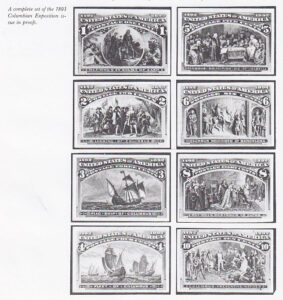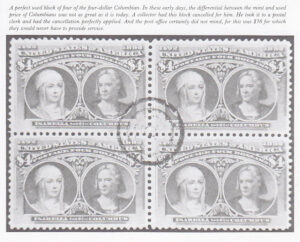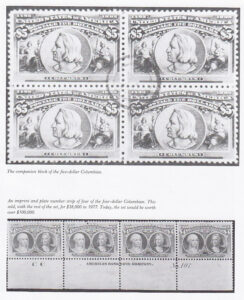Perhaps the most popular United States series is the 1893 Columbian Exposition issue. In its day, the set was hotly debated boondoggle, causing protests from philatelists around the world. It helped create the organization of the Society for the Suppression of Spurious Stamps (or SSSS, as they called themselves). And it caused the post office no end of joy at the profits it reaped. Such post office profiteering was quite conscious. In their memos to one another, it was apparent that the postal officials designed the set so that sales of the stamps to collectors would increase Post Office Department revenues.


The occasion of the issue was the 400-year anniversary celebration of Columbus’s discovery of the New World– a celebration held, somewhat belatedly, in Chicago in 1893. The Columbians, as philatelists refer to the set, were the world’s first commemorative stamps. Commemoratives are special event stamps issued to draw attention to an event. Such commemoratives are quite popular today, with some thirty or more issued annually.
Being a new series, actively promoted by the government, and having so very many high-valued stamps, the Columbians were speculated in heavily right from the start. To a very real extent, this set can be said to be the first to attract investors. And they got walloped! Following what seems to be the unwritten lemming rule of most stamp speculators, hundreds of collectors put away thousands of these Columbian stamps, far more than the tiny stamp market of the 1890s could accommodate. For over twenty-five years after their issue, dollar-value Columbians usually traded at discounts from face value. However, this situation turned about quite radically once the original hoards were dispersed; dollar-value Columbians began to rise in the late 1920s and have apparently not stopped even today. A set of Columbians that cost $16.24 in 1893 would cost about$10,000 today, depending on condition. Not bad for a set that nobody wanted.
The Columbians were sent to the post offices late in 1892, and were scheduled to be valid for postage on January 1, 1893. January 1 was a Sunday, and very few of the stamps were used on that day. Because January 2 was the first day on which open post offices cancelled mail, it has been designated the first day of this stamp. In this very early period, first-day covers generally are accidentals, that is, a postal patron happened to buy a stamp and use it on the first day, and the cover is later discovered by philatelists. First-day covers are known back to the one cent 1851, but before 1910 they usually are rarities selling for thousands of dollars. The two cent Pan American (#295) has been seen by the authors on a May 1, 1901, first-day cover used by Gimbels Department Store to one of its customers with an enclosure of a bill for several hats. Apparently Gimbels sent out hundreds of bills that month in covers that today are worth several thousands dollars each.
The Columbian lower values are much more common used than they are mint. The higher values, above the $1, are about as common mint as they are used, but the mint sell for about three times as much as the used stamps. This is because over the last thirty years, collector fashion has swung to where issues after 1890 are far more popular unused than used. In the 1950s there was not nearly such a difference in price between mint and used.
About 25,000 of the $4 and $5 values were sold, but the overwhelming majority of these stamps are now defective. For some reason, the paper that these stamps were printed on thinned, creased, or got scuffed with the greatest of ease. Ninety-five percent of Columbian stamps have some fault or another. A beautiful-looking set with tiny thins would sell for about one-sixth of what a perfect set would. It is for each collector to decide for himself what quality is worth.


